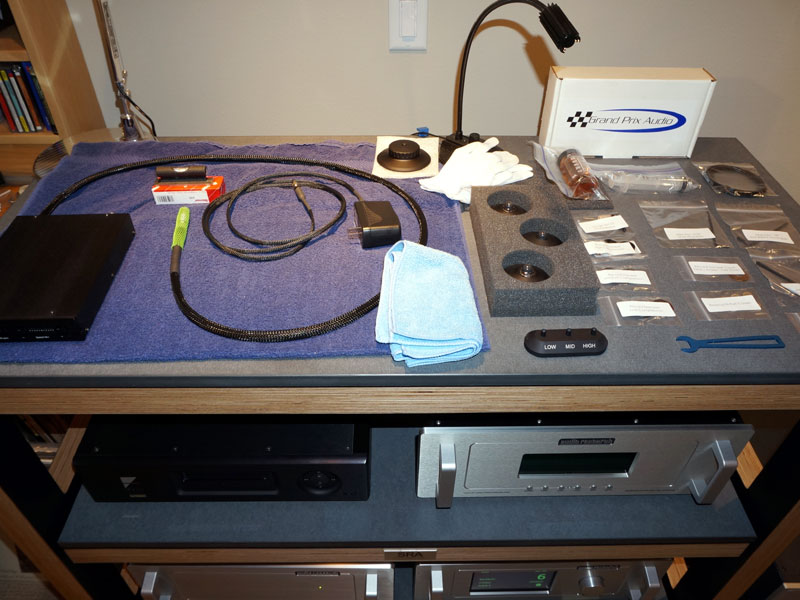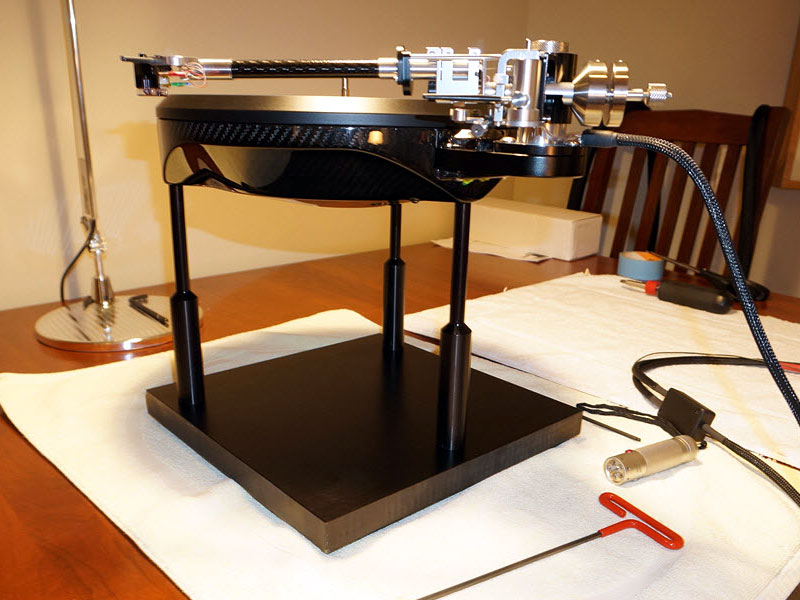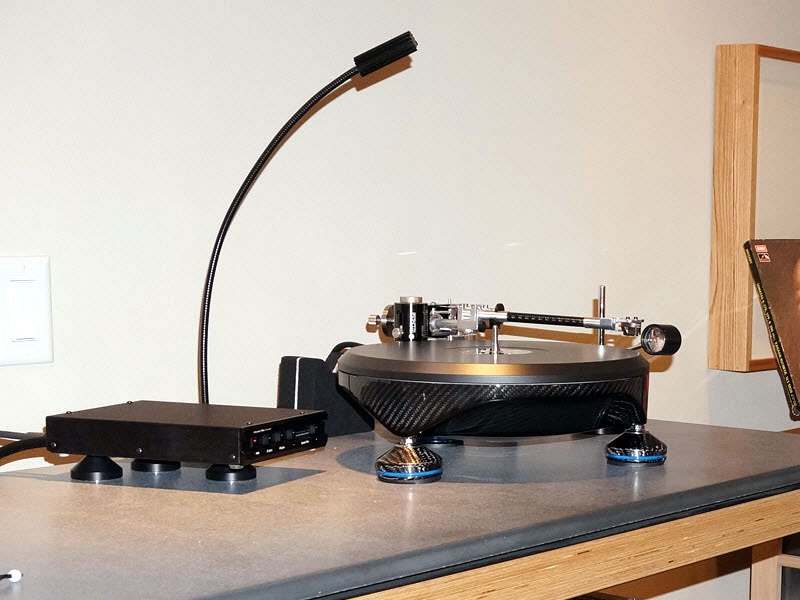Rolling the Dice with the Monaco 1.5
ometimes upgrades have unintended consequences. System infrastructure improvements I made to power conditioning, vibration management and acoustic control over the past two years significantly lowered distortion while increasing musical veracity and satisfaction. But it was the addition of the Audio Research Reference 10 line stage that pushed down the noise floor to the point where, ironically, previously unheard noises broke through it. I heard a periodic noise from my rim-driven Teres 320 turntable, particularly on the first half of records containing quiet acoustic music such as violin quartets and piano sonatas. Noise from the rim drive was coming through the platter. I also noticed what I’ll call position wavering from musicians and instruments -- likely rumble, wow and flutter, which had been there all along. In short, the resolution of my system had increased to the point where I needed a new turntable. Reasoning that the starting point for everything musical proceeds from the source, I wanted my next ‘table to be both the bedrock component of my record collection and the final turntable I would need. I wanted a ‘table that was sonically invisible. It had to be operationally inaudible, deliver near-to-perfect speed accuracy across an album side (record after record,) easily accommodate switching tonearms, be reliably simple to use while not being fiddly or requiring continual mechanical adjustment or parts replacement. I didn’t need shiny bling, an antique or a beautiful piece of furniture. I didn’t want to find maintenance and support only overseas. Six months of reading manuals, forums, reviews and listening to experts like Gregory, Mickelson, Fremer, and Moncrieff confirmed my thinking: I wanted the best direct-drive ‘table I could afford that came darn close to meeting all my criteria. The decision to spend the money was hard; the rest was easy.
The Monaco 1.5 ($23,800) arrived from Grand Prix Audio designer and CEO Alvin Lloyd in a sturdy wooden crate. The 'table’s components were well-padded, and the tools needed to set it up were clearly labeled in individual packaging. The manual even included step-by-step instructions for unpacking the crate. It was clear that Lloyd made the effort to think of everything. My first impressions held true throughout the entire setup process: the Monaco 1.5 was like a fine scientific instrument built to the standards of high-precision engineering. Getting the Monaco to the point where I was playing music was simple. The plinth and platter (with motor and bearing) are an integrated unit and the armboard for my Tri-Planar Mk II U2 SE came pre-installed. Without going through the process in detail, I will describe some of what I learned during setup. The bottom of the Monaco 1.5’s elegant carbon-fiber housing is saucer shaped. It needs to sit on its three feet to stay upright. When the 'table is on those feet, the platter sits less than five inches high and the underside of the 'table, where the armboard bolts are located, is inaccessible. Grand Prix offers an optional anodized aluminum jig ($900) that raises the ‘table to a near ten-inch working height. The jig holds the Monaco 1.5 rock steady, gives access to those tonearm bolts and generally places the table in better position for working on it and doing cartridge alignment. It’s the difference between crawling under the car without jack stands versus having a lift. Alvin sent me a jig on loan, but I found it invaluable when setting up the Monaco 1.5 and consider it a necessity for changing tonearms, unless I have a helper available to lift the 'table. If you’re setting up the 'table on your own, I strongly recommend borrowing this jig. Going forward, I plan to change tonearms and cartridges, so I bought the loaner. Before mounting the ‘table on the jig, I used blue painter's tape to fix the platter to the plinth. The platter must not rotate until oil is put in the bearing.
Regarding tonearm installation, the manual states: "Our [arm board] installation obviates any need to inspect the mounting location or pivot point of the arm." If your tonearm is perfectly true, the Monaco 1.5’s armboard position is exact. Nonetheless I used an Acoustical-Systems P2S device to confirm the Tri-Planar’s pivot-to-spindle distance was precisely 233.5mm. If that measurement is not correct, no others will be. The Tri-Planar separates its bearing assembly from its VTA tower that is bolted to the armboard and allows adjustment between those two sections. That can alter measurements based on out-of-the-box tonearm defaults. Good thing I checked because my Tri-Planar was slightly off and required adjustment to hit the mark exactly. I quickly learned that I could trust the accuracy of the Monaco 1.5’s precision construction. It never let me down. I kept the 'table on the jig for initial cartridge setup; otherwise my head would be lying flat on the bench to see the cantilever. I used Wally Malewicz’s WallyVTA gauge to set precisely the tonearm parallel to a record and then I balanced the 'arm. Cartridge alignment was done with Acoustical-Systems’ UNI-Protractor device. I’ve used most of the protractors on the market; the UNI and its little brother, the SMARTractor, are the most confidence-giving and easiest-to-use devices of their type that I’ve found.
To measure vertical tracking force I normally use a home-built version of Malewicz’s WallyScale. It uses an acrylic bar that sits on a standard electronic scale and features a cantilevered platform hanging off the record to set the weighing position at record height. As Alvin Lloyd later confirmed, this type of scale does not work with the Monaco 1.5 because its platter slopes outward and there is no room for the cantilevered platform between the platter edge and the cartridge. I ended up buying an electronic stylus-force gauge that sat completely on the platter. Grand Prix includes a Starrett machinist's level and a custom wrench for leveling the 'table by adjusting only two of its three feet. These tools and the fine pitch on each foot’s adjuster thread made the leveling process easy and straightforward -- another example of just how well thought out the whole Monaco 1.5 package is. I checked for level at the 12:00, 3:00, 6:00 and 9:00 positions with the level both horizontal and vertical. The Monaco 1.5’s bearing sits submerged in oil and (as I learned) overfilling it means excess oil will leak out the bottom of the ‘table. Alvin assured me that no harm is done; just use a cloth or paper towel under the ‘table to soak up any excess. Here’s the technique I came to for getting the oil fill just right: fill the supplied syringe with 8ml of supplied oil; the bearing requires 7.5ml. As instructed in the manual, insert the syringe into one of the oil ports and slowly inject 5ml. Wait 30 minutes, then inject 2ml. Wait again, then use the supplied dipstick. Don’t stick it down into the bearing; instead sit it on the lip or flange of the bearing housing out of the oil, then slowly lower it toward the oil surface, watching for a break in surface tension. This will tell you how close the oil is to the lip. If the oil is right at the edge of the lip, you’ll need to wait a bit longer for any trapped air to clear. Slowly, slowly drip in another 0.5ml of oil, again using the dipstick to check the level by way of surface tension. When the oil is just barely below the top of the housing lip, the bearing is full. The manual includes a diagram of the bearing that makes it all clear. I used a cotton ball with just a touch of acetone to clean the oil-port area before applying the covers. After connecting the cables and the controller box (with its 40 MIPS computer!) the Monaco 1.5 spun its platter on the first go. With a hearty "If I can do it you can too" exclamation, I can only describe the ‘table install as simple, largely thanks to the well-thought-out process, clear manual and precision fit of everything. I used a USB microscope to get stylus SRA at 90 degrees and adjusted by ear from there. (Personally, I find these microscopes’ software too dependent on end-user skill. Be off by a pixel when tracing the stylus outline with your mouse and you’ll get a different numerical result with each drawing.) I used a Fosgate Fozgometer to get the stylus’s axial tilt to achieve optimal channel separation, and then checked that by ear. Operation of the Monaco 1.5 is simple: select a damping ring from the supplied holder to place on the spindle according to record thickness, put on a record, and screw down the clamp to secure the record against the platter. If you overtighten the clamp or don’t tighten it enough you can flatten the musical presentation and turn the timbre dry. I suggest experimenting with a record you know well to find what works best for you. I used the Low compression washer most frequently on the spindle with the Medium washer used for 180-gram and heavier LPs. With the clamp in place, turn on the controller and press the appropriate speed button. Speed acquisition is quick. Alvin explained that you can stop the platter quickly by hand and you can spin it by hand for even quicker start up. The Monaco 1.5 sonically exceeded all I hoped for from my new turntable. There was no audible mechanical noise, no bearing noise, no periodic noise, no sense of slow or fast variation in speed. Record surface noise, when present, seemed to gather itself into a plane of lower audibility that rode below and apart from the music, not within it. The Monaco 1.5’s silent accuracy cashed out musically as eliminated distortion. With the Monaco 1.5 in my system music poured forth from records with confident purpose and authority as if emerging from a black-granite foundation. As a machine, the Monaco 1.5 took itself out of the musical picture, while making that picture possible. In doing so, the tonearm and cartridge emerged as the observable sonic influences with the ‘table setting the stage on which they performed. Indeed, cartridge and ‘arm setup became easier because their performance became easier to assess. Small changes to VTF, SRA and azimuth were more obvious than I’d previously known. The structure of lower-frequency information was organized and made coherent as shadows and shapes resolved out of previous cloudy backgrounds. On each record of acoustical music I played there was no sense of fuzz or blur surrounding sustained notes; images were rock steady without any wavering of performers. Musicians played like they had a good night’s sleep. Silent accuracy made obvious subtleties of performances previously obscured. I felt more in touch with the presence and humanity of the music and the music makers. I heard new clarity and distinctness to mirrored vocals; just listen to Nora Jones sing "My toes just touched the water" for an example. Music coming off the Monaco 1.5 simply felt right. I didn’t have to think about; I knew it from track one.
Upgrading to the Monaco 1.5 had no unintended
consequences. There were no surprises during setup, and I can’t say enough about the
friendly mien and solid advice I received from Alvin Lloyd. What a great machine. I wish
I'd had this turntable all along. |



